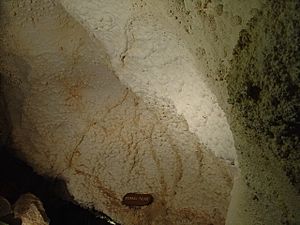Grand Canyon Caverns facts for kids
Quick facts for kids Grand Canyon Caverns |
|
|---|---|
| Ŧathiil Ñwaʼa | |
|
Cave popcorn at the Snowball Palace in Grand Canyon Caverns
|
|
| Location | Peach Springs, Arizona, United States |
| Depth | 210ft |
| Length | 2406ft |
| Elevation | 5500ft |
| Discovery | 1927 |
| Geology | Limestone |
| Difficulty | low-Medium |
| Website | gccaverns.com |
The Grand Canyon Caverns are amazing underground spaces located near Peach Springs, Arizona. They are also known by their Hualapai names, Ŧathiil Ñwaʼa or Ŧathiil Ñhaʼa. These caverns are about 210 feet (64 m) deep, which is like going down a 20-story building!
They are some of the biggest "dry caverns" in the United States. This means they don't have much water dripping inside. Because of this, you won't see many stalagmites or stalactites, which are cave formations that need water to grow. Only about 3% of all caves in the world are dry like these!
Millions of years ago, the area where the caverns are now was covered by an ocean. Tiny sea creatures lived and died, and their skeletons settled on the seafloor. Over time, this created a thick mud rich in calcium. This mud eventually hardened into the limestone rock you see in the caverns today.
About 35 million years ago, rainwater started flowing into cracks in the rock. This water slowly carved out tunnels and passages. These passages eventually led to the Colorado River and what we now call the Grand Canyon. As the water evaporated over millions of years, it left behind calcium deposits on the cave walls and floors. These deposits formed the unique shapes and features you can explore today.
Contents
Discovering the Caverns
In 1927, a man named Walter Peck found the caverns by accident while looking for gold. He decided to open them to visitors and charged 25 cents to get in. For a while, people could even see what was thought to be a "caveman" inside! Later, it was discovered that these were the remains of two Hualapai Native Americans. They had died in the winter of 1917–1918 during a snowstorm. Because the ground was frozen, they were buried in what seemed like a small hole.
In 1935, groups like the Civilian Conservation Corps helped build a new entrance to the caverns. Then, in 1962, a big change happened. Workers blasted a 210-foot (64 m) shaft into the rock and put in a large elevator. This made it much easier for people to visit! The original natural entrance was then closed off. This was done at the request of the Hualapai people, who considered it a special burial place.
Near the natural entrance, scientists also found the bones of a giant ground sloth. This huge animal, called a Paramylodon harlani, lived about 11,000 years ago. That was a time when woolly mammoths and saber-toothed cats roamed North America!
Names Through Time
When Walter Peck first found the caverns, he called them Yampai Caverns. But the name changed a few times over the years.
- Until 1957, they were known as The Coconino Caverns.
- From 1957 to 1962, they were called The Dinosaur Caverns.
- Finally, in 1962, they got their current name: The Grand Canyon Caverns.
A Cold War Shelter
During the 1962 Cuban Missile Crisis, the U.S. government chose the caverns as a fallout shelter. This meant they were a safe place for people to go in case of a nuclear attack. Supplies for 2,000 people were stored there, and you can still see some of these supplies today!
In 1979, a special telescope was set up 126 feet (38 m) below the surface in the caverns. This telescope was used to study cosmic rays, which are tiny particles from space.
What You Can Do There
The Grand Canyon Caverns area offers more than just the caves! You can find a hotel called The Grand Canyon Caverns Inn, an RV park for campers, and even campgrounds. There's also a restaurant, a convenience store, and a 5,100-foot (1,600 m) runway for small planes.
How the Land Formed
The caverns are located on the Coconino Plateau, a flat, high area. They sit in a valley at about 5,300 feet (1,600 m) above sea level. The ground here is mostly made of limestone. This limestone is full of many other cave systems that stretch for miles in all directions.
Images for kids





